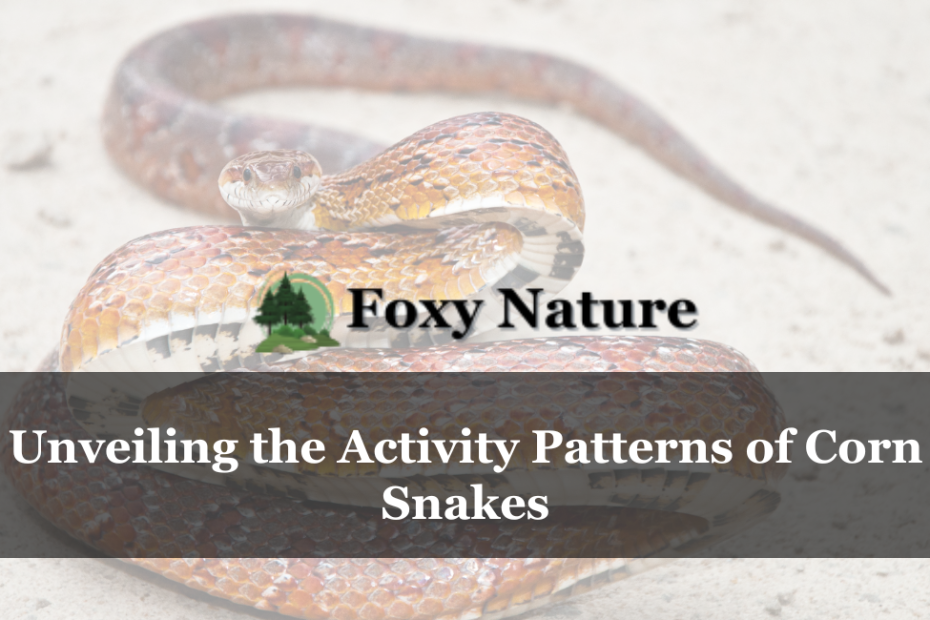Corn snakes, with their vibrant scales and captivating hunting techniques, have captivated snake enthusiasts for decades. One of the most common questions surrounding these intriguing reptiles revolves around their activity patterns.
While many might assume corn snakes are solely active under the cloak of darkness, the truth is more nuanced. This article delves into the fascinating world of corn snakes, exploring their crepuscular nature and the various factors that influence their activity levels.
Untangling the Terminology
Before delving into the specific case of corn snakes, it’s crucial to establish a clear understanding of the different activity patterns exhibited by various animals:
- Nocturnal: These creatures thrive in the cool, quiet hours of the night, primarily engaging in hunting, foraging, and social interactions during this time. Conversely, they rest and seek shelter during the day, often hidden away in burrows, caves, or dense foliage. Examples of nocturnal animals include owls, bats, and raccoons.
- Diurnal: These animals are most active during the day, utilizing the daylight hours for essential activities like hunting, feeding, and social interactions. As dusk approaches, they typically retreat to their shelters to rest and sleep. Examples of diurnal animals include lions, zebras, and most birds.
- Crepuscular: This category encompasses animals exhibiting peak activity during the twilight hours, both at dawn and dusk. They often capitalize on the fading or rising light to optimize their hunting success while avoiding the intense heat of midday or the complete darkness of night. Examples of crepuscular animals include foxes, deer, and many rodents.
Corn Snake’s Activity Cycle
Contrary to popular belief, corn snakes are not nocturnal. They fall under the category of crepuscular animals, meaning their peak activity periods occur during the twilight hours, specifically at dusk and dawn.
This timing coincides strategically with the activity patterns of their primary prey, rodents and lizards, which are also most active during these twilight periods.
By being active during these times, corn snakes can efficiently hunt and forage for food while minimizing the risk of encountering potential predators, many of which are diurnal or more active during the day.
Factors Influencing Corn Snake Activity Levels
While corn snakes are naturally crepuscular, their activity levels can be influenced by several factors, demonstrating their remarkable adaptability:
- Habitat: In their natural environment, corn snakes may adjust their activity patterns based on factors like the availability of prey and ambient temperature. For instance, in cooler climates with shorter daylight hours, they might be more active during the day to maximize their body temperature by basking in the sun’s rays. Conversely, in warmer climates with longer daylight hours, they may be more active during the cooler twilight periods to avoid the scorching midday heat.
- Captivity: Pet corn snakes, once adapted to their enclosures and comfortable with their surroundings, may exhibit a wider range of activity throughout the day. However, they often retain a preference for twilight hours, aligning with their natural instincts. This is because their internal clocks, known as circadian rhythms, are still influenced by the light-dark cycle, even in captivity.
Understanding Their Sleep Cycle
Like most reptiles, corn snakes require adequate rest and sleep to maintain their energy levels and overall health. They typically sleep for 10-15 hours daily, with the exact timing varying based on factors like their age and the environment they inhabit.
In their natural habitat, they often adhere to two distinct sleep cycles, one during the day and another at night. This sleep-wake pattern allows them to conserve energy and remain alert during their peak activity periods.
Keeping Corn Snakes as Pets
If you’re a proud owner of a corn snake, understanding their natural activity patterns is crucial for providing them with optimal care. Here are some key points to remember:
- Feeding: As corn snakes are most active during dawn and dusk in their natural habitat, scheduling their feeding sessions during these times in captivity aligns with their natural instincts and hunger cues. This can help ensure they readily accept their food and maintain healthy eating habits.
- Temperature: Corn snakes are ectothermic, meaning they rely on external sources to regulate their body temperature. Providing a temperature gradient within their enclosure, with a warm basking area and a cooler zone, allows them to thermoregulate effectively. This is particularly important during the night, as temperatures may drop, and corn snakes need to maintain their body temperature within a specific range for optimal functioning.
Conclusion
In conclusion, by uncovering the activity patterns of corn snakes, we gain valuable insights into their behavior and natural rhythms.
Understanding these patterns not only enhances our appreciation for these fascinating reptiles but also aids in their conservation and welfare. Let’s continue to explore and appreciate the wonders of nature, one discovery at a time.
